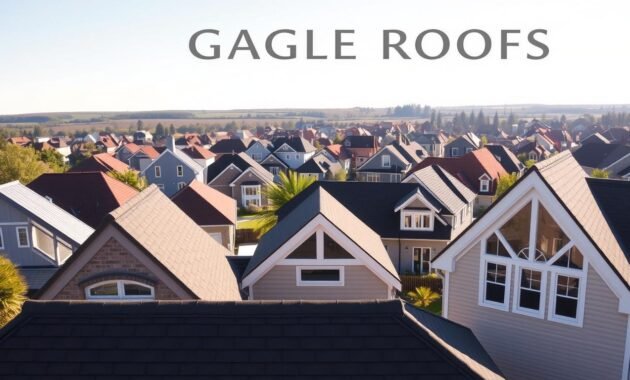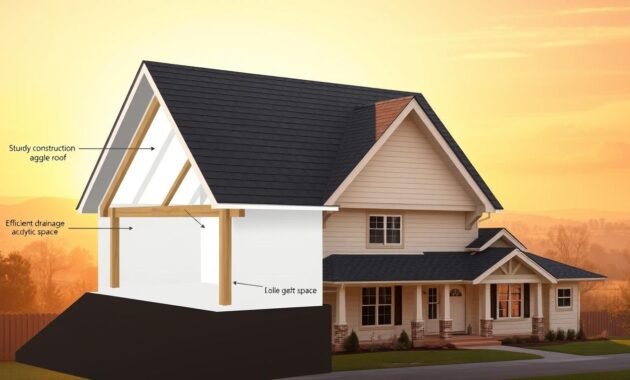Are you tired of roof designs that drain poorly and cost a fortune? Many homeowners struggle with inefficient roofing. It fails to protect their homes effectively. Traditional roof styles often leave you battling water damage, high energy costs, and limited interior space.
Enter the gable roof—a game-changing type of roof that solves these frustrating problems.
As a home design enthusiast, I’ve discovered that a gable roof is more than just a simple architectural feature. This classic roof design consists of two sloping sides that meet at a central ridge. It creates a distinctive triangular shape at each end of the building.
Read also: What Is a Gable Roof? Simple Explanation
Its popularity stems from its incredible practicality, which is a big plus in regions like the Northeast United States.
I’ll walk you through everything you need to know about this versatile gable roof design. I’ll help you understand why it might be the perfect solution for your home.
Understanding Gable Roof Basics
Gable roofs are a key architectural design that’s both simple and functional. Their unique triangular shape is why many homeowners choose them. They offer a practical and attractive roofing solution for homes and businesses.
Key Components of a Gable Roof
A gable roof has important parts that work together to provide a strong cover. The main parts are:
- Ridge board: The horizontal beam at the roof’s peak
- Common rafters: Sloping wooden members from the ridge to the walls
- Roof decking: Plywood or OSB for a solid base
- Roof trusses: Triangular structures that support the roof’s weight
How Gable Roofs Are Constructed
Building a gable roof is based on a simple design. It ensures water drains well and withstands wind. Carpenters use precise measurements and framing techniques for a strong roof.
Experts say at least three carpenters are needed to safely set the ridge board. The layout is like ceiling joists, making the structure stable and strong against winds.
Common Materials Used
| Material Type | Durability | Cost Range |
|---|---|---|
| Asphalt Shingles | 15-30 years | $100-$200 per square |
| Metal Roofing | 40-70 years | $200-$900 per square |
| Clay Tiles | 50-100 years | $300-$1000 per square |
Choosing the right materials is key for a gable roof that lasts. It should handle different weather conditions while keeping its design and strength.
Different Types of Gable Roofs
Gable roofs have many designs, each with its own look and benefits. Knowing about these types helps homeowners and builders pick the right one for their needs.

Open Gable Design
The open gable roof is the most traditional and simple. It has a triangular shape and exposed rafters. This design is great for shedding water and snow. It’s popular in places with a lot of rain or changing weather.
Box Gable Configuration
A box gable roof has enclosed triangles at each end. It’s stronger and looks more finished. This design is perfect for those who want a clean, geometric look while keeping the roof’s practical benefits.
Cross Gable Structure
The cross gable roof is more complex, with two or more sections meeting at right angles. It’s great for homes with many wings or odd floor plans. This design adds visual interest and architectural flair to homes.
- Front gable roofs position the triangle facing the street
- Side gable roofs run parallel to the street
- Cross gable roofs offer maximum design flexibility
Every gable roof type has its own look and benefits. Homeowners can choose one that fits their style and local weather.
What Is a Gable Roof and How Does It Work?
A gable roof is a common roof type in North America. It has two sloping sides that meet at a ridge. This design creates a triangular shape that helps manage water and snow.
The way a gable roof works is quite interesting. Here’s how it functions:
- Water and Snow Shedding: The steep pitch allows quick runoff, preventing water and snow accumulation
- Ventilation: Sloped sides create natural airflow, reducing moisture buildup
- Structural Flexibility: Can adapt to various home designs and architectural styles
The roof’s performance depends on its pitch angle. In cold areas, steeper roofs (45-62 degrees) keep snow off better. Places with strong winds might need special designs to avoid damage.
Homeowners like gable roofs for many reasons. They offer great attic space, allow for dormers, and look traditional. This roof fits well with many home styles, from ranch to Cape Cod.
Advantages of Choosing a Gable Roof Design

Gable roof designs are a top pick for homeowners. They offer benefits that go beyond just shelter. These roofs are practical for today’s homes.
Cost-Effective Construction
Gable roofs are an affordable choice. Their simple design means faster building and lower labor costs. This saves homeowners money.
- Straightforward design reduces construction time
- Lower material expenses
- Simplified installation process
Maximum Attic Space Utilization
Gable roofs offer more attic space. Their steep pitch adds vertical room. This lets homeowners use the space for storage or even living areas.
- Greater vertical clearance
- Increased storage capacity
- Possibility of future attic conversions
Enhanced Ventilation Benefits
Gable roofs are great for ventilation. Their design helps air flow, keeping temperatures stable and reducing attic moisture.
- Natural air circulation
- Improved temperature regulation
- Reduced moisture accumulation
Choosing a gable roof means cost savings, more attic space, and better air flow. It’s a wise choice for building homes.
Gable Roof Performance in Different Climates
Gable roofs are great for many climates. They work well in cold and temperate areas but face challenges in windy places.
In snowy northern areas, gable roofs are excellent. Their steep slope helps snow and rain slide off, avoiding water damage. This is key in places with lots of snow and rain.
- Efficient snow and rain shedding
- Superior water runoff capabilities
- Enhanced attic ventilation
But, windy areas are a different story for gable roofs. Wind damage can be a big problem, mainly if roof overhangs are too long. People living in areas hit by hurricanes need to make sure their roofs are strong.
To deal with wind, consider these steps:
- Keep roof overhangs under 30 inches
- Use hurricane straps for extra support
- Choose wind-resistant roofing materials
- Use proper roof framing
Gable vents help a lot by improving airflow and stopping moisture. Metal shingles are also a good choice for windy areas. They add strength in bad weather.
Comparing Gable Roofs to Hip Roofs
Choosing the right roof for your home is important. Knowing the differences between gable and hip roofs can help. Each has its own benefits and drawbacks, like cost and how well they handle wind.
Structural Differences
Gable and hip roofs look and work differently. Gable roofs have two sides that meet at a ridge, forming a triangle. Hip roofs, on the other hand, have slopes on all four sides, making them look like a pyramid.
- Gable roofs have two main roof planes
- Hip roofs have four sloping sides
- Hip roofs are more stable because of their design
Cost Comparison
Cost is a big factor when choosing a roof. Gable roofs are cheaper because they’re simpler. Hip roofs need more materials and complex framing, making them more expensive.
| Roof Type | Average Installation Cost | Material Requirements |
|---|---|---|
| Gable Roof | Lower | Fewer materials |
| Hip Roof | Higher | More complex materials |
Weather Resistance
In areas with strong winds, how well a roof holds up is key. Hip roofs are better at resisting wind than gable roofs. Their shape helps them stay strong during storms.
- Hip roofs need less diagonal bracing
- Gable roofs are more at risk in strong winds
- Insurance discounts can be up to 32% for hip roofs in hurricane zones
Your choice depends on your local weather, budget, and what you like. Talking to a roofing expert can help you pick the best roof for your home.
Design Considerations for Gable Roofs
Designing a gable roof needs careful planning. It must be both functional and beautiful. Gable sections are great for homeowners who want a simple yet stylish roof.
When designing a gable roof, several important factors come into play:
- Roof Pitch: The angle of slope affects the roof’s look and how well it works
- Architectural Style: The right pitch angle matches different home designs
- Climate Considerations: Steeper slopes are better in areas with lots of snow
- Material Selection: The choice of roofing materials affects the design and how long it lasts
I suggest looking at various gable sections to create unique roof designs. Homeowners can mix different gable types for a more complex and interesting roof.
| Gable Roof Type | Design Characteristics | Best Suited For |
|---|---|---|
| Side Gable | Simple, symmetrical design | Traditional home styles |
| Cross Gable | Intersecting roof planes | Complex architectural designs |
| Front Gable | Prominent entrance feature | Colonial and craftsman homes |
Adding features like dormers or skylights can make your gable roof more functional and attractive. Always talk to a professional roofing contractor. They can make sure your design follows local building codes and meets structural needs.
Read also: Choosing Low Sloped Roof
Maintenance and Durability Factors
Gable roofs need careful care to last long, mainly in windy areas. Keeping them well-maintained can save you from expensive fixes.
Common Issues to Watch For
Homeowners should watch out for problems that can harm their gable roof. These roofs face special challenges in windy weather, like:
- Wind damage to roof edges and corners
- Shingle deterioration
- Water infiltration at roof valleys
- Potential structural weakening in extreme weather
Preventive Maintenance Tips
It’s smart to take a proactive stance on gable roof care. Regular checks can spot and fix issues early on.
- Conduct bi-annual roof inspections
- Replace damaged or missing shingles promptly
- Ensure proper attic ventilation
- Clean gutters and downspouts regularly
Read also: How to Replace Missing Shingles
| Maintenance Task | Frequency | Purpose |
|---|---|---|
| Visual Roof Inspection | Twice a Year | Detect Early Damage |
| Gutter Cleaning | Seasonal | Prevent Water Backup |
| Shingle Replacement | As Needed | Maintain Roof Integrity |
In windy areas, think about extra support for your gable roof. Using strong materials and proper anchoring can make your roof last longer and work better.
Conclusion
Exploring what a gable roof is, I find it’s a great choice for homes. It’s versatile and practical. Many homes in the U.S., where it’s cold or moderate, choose this roof.
Gable roofs are cost-effective and useful. They drain water well, offer attic space, and need less upkeep. But, you must install them right, use quality materials, and maintain them to last.
Choosing a gable roof means thinking about your local weather and home design. These roofs have many benefits, but you need to build them well to avoid problems. Working with experts and knowing what gable roofs offer can help you choose wisely.
In the end, gable roofs are a popular pick for their value, usefulness, and design flexibility. Whether you’re building or replacing a roof, knowing about gable roofs can guide your decision.




